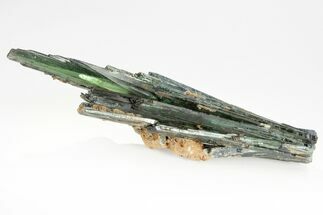1.7" Translucent Blue-Green Vivianite Crystals on Pyrite - Romania
This is a cluster of gorgeous blue-green vivianite crystals, collected from the Roșia Poieni Mine in Alba County, Romania. The crystals are in excellent condition and are still attached to a section of matrix. Their color stands out when holding them in front of a light source.
It has been mounted to an acrylic display base with mineral tack.
It has been mounted to an acrylic display base with mineral tack.
About Vivianite
Vivianite is a hydrous iron phosphate mineral that appears in flat, prismatic crystals. This mineral is highly sought after for its deep teal coloring and crisp translucence. It looks like a mystical glass that may be found in a fantasy movie. While it is commonly an iron phosphate mineral, occasionally the iron ion maybe substituted for magnesium, calcium, or manganese.
Even though it is prized for its color, it does not begin its existence in a glassy blue-green state. Vivianite is originally completely clear. However, when exposed to light, the crystals begin a chemical reaction, converting the iron(ii) ion into the iron(iii) ion. When this happens the mineral gradually shifts to a blue and then into a blue-green and keeps deepening in color until it is almost opaque black. Vivianite will color shift at different rates depending on the amount and intensity of the light it is exposed to. Therefore it is never truly stable, but as long as its exposure time is limited it should remain a consistent color for quite some time.
The highest quality vivianite crystals typically appear within hydrothermal veins. However, vivianite is occasionally found in association with fossils, especially lining the shells of bivalves or gastropods. A mummified steppe bison discovered in Alaska was coated in blue-green vivianite crystal oxidation, lending the specimen the nickname "Blue Babe".
Vivianite is a hydrous iron phosphate mineral that appears in flat, prismatic crystals. This mineral is highly sought after for its deep teal coloring and crisp translucence. It looks like a mystical glass that may be found in a fantasy movie. While it is commonly an iron phosphate mineral, occasionally the iron ion maybe substituted for magnesium, calcium, or manganese.
Even though it is prized for its color, it does not begin its existence in a glassy blue-green state. Vivianite is originally completely clear. However, when exposed to light, the crystals begin a chemical reaction, converting the iron(ii) ion into the iron(iii) ion. When this happens the mineral gradually shifts to a blue and then into a blue-green and keeps deepening in color until it is almost opaque black. Vivianite will color shift at different rates depending on the amount and intensity of the light it is exposed to. Therefore it is never truly stable, but as long as its exposure time is limited it should remain a consistent color for quite some time.
The highest quality vivianite crystals typically appear within hydrothermal veins. However, vivianite is occasionally found in association with fossils, especially lining the shells of bivalves or gastropods. A mummified steppe bison discovered in Alaska was coated in blue-green vivianite crystal oxidation, lending the specimen the nickname "Blue Babe".
$39
SPECIES
Vivianite & Pyrite
LOCATION
Roșia Poieni Mine, Mușca, Lupșa, Alba County, Romania
SIZE
Entire specimen: 1.7 x .85"
CATEGORY
ITEM
#309774
 Reviews
Reviews









